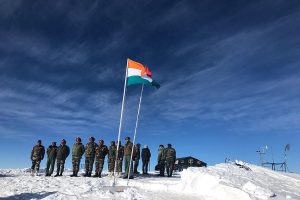If they are not a spitting image of each other they are at least joined at the hip, these inspired people who are rewriting history textbooks in India and Pakistan.
The inevitable target of their bogus and potentially violent writings are the minorities — non-Hindus in India and non-Muslims in Pakistan.
Advertisement
Consider the latest attempt at subversion from India. According to reports on Thursday, ministers in the Bharatiya Janata Party-ruled (BJP) Rajasthan state have proposed that the outcome should be rewritten in the mediaeval battle of Haldighati that was fought between the forces of Mughal emperor Akbar and Rajput chieftain Rana Pratap.
It ended in a stalemate with the latter retreating deeper into Mewar, but Hindutva historians are determined to show him as the clear victor.
It is less widely admitted that his Rajput General Mansingh led Akbar’s 1576 campaign.
If Hindutva historians have their way they would project even Alexander of Macedonia as an anti-India Muslim marauder.
Cinematic versions of Alexander’s war with King Porus have already attempted this in a way, showing the foreigner speaking in Urdu, implying a Muslim language, while the vanquished Indian ruler spoke chaste Hindi, erroneously projected as a Hindu language.
It would be equally embarrassing for Hindutva historians to admit that Maratha king Shivaji communicated with his arch-foe Emperor Aurangzeb in Persian while conducting his Maratha empire’s administration in Modhi, a less discussed precursor of Marathi.
It is routine among Hindutva historians to claim mediaeval monuments as Hindu structures grabbed by Muslims. According to P.N. Oak, an early myth-maker in this genre, Taj Mahal was a Hindu palace as was the Asafi Imambarha of Lucknow.
According to Oak, Christianity is Chrisn-nity, an ascription to Lord Krishna. “Christianity is in fact a popular variation of the Hindu, Sanscrit [sic] term Chrisn-neety, i.e. the way of life preached, advocated or exemplified by the Hindu incarnation Lord Chrisn, spelled variously as Crsn, Krsn, Krishn, Chrisn, Crisna or Krisna also,” Oak wrote.
To keep the spirit from flagging, even Wagner’s theory of continental drift was harnessed to claim that light-skinned Indians originally came from the border of Bihar and Orissa.
Later, the border drifted away to form the North Pole, thus implying that Caucasian and Central Asian genes travelled from India to their current abode, not the other way round.
As in India, rigging the chronology of history has been honed into a craft in Pakistan too, and it is difficult to say who between the two is better in conjuring myths that exhort young minds to violence.
A recent study in Pakistan found that the country’s public school textbooks negatively portrayed religious minorities, including Hindus, Christians and Ahmadis, as “untrustworthy, religiously inferior, and ideologically scheming”.
The report, “Teaching Intolerance in Pakistan: Religious Bias in Public School Textbooks”, analysed 78 textbooks from all four provinces covering grades five through 10.
The US Commission on International Religious Freedom (USCIRF) sponsored the study, which was conducted by a Pakistan-based NGO, Peace and Education Foundation (PEF). The study found 70 new instances of bias in addition to finding that some problematic content found in a 2011 study conducted by USCIRF had remained and even been expanded upon.
“Pakistan’s public school textbooks contain deeply troubling content that portrays non-Muslim citizens as outsiders, unpatriotic, and inferior; are filled with errors; and present widely-disputed historical ‘facts’ as settled history,” USCIRF Chairman Robert P. George said in a statement on the report’s release.
“Missing from these textbooks are any references to the rights of religious minorities and their positive contributions to Pakistan’s development.”
“These textbooks sadly reflect the alarming state today of religious freedom in Pakistan,” he concluded. “A country’s education system, including its textbooks, should promote religious tolerance, not close the door to cooperation and coexistence.”
The 52-page report contains many examples of a troubling portrayal of religious minorities in the public school textbooks.
A passage in an eighth grade Islamic Studies book, published in 2015 as part of the Khyber Pakhtunkhwa curriculum, describes Jihad in a fraught way.
“Jihad will continue till the end of times. Jihad is going on in different parts of the world. Many Mujahidin of Islam are participating in Jihad for sake of Allah, for protection of their religion, to help their oppressed brothers, and to get freedom from tyranny,” it read. “As a student if you cannot practically participate in Jihad you can at least financially help in preparation of Jihad.”
A passage from a tenth grade Punjab textbook, also published in 2015, states: “Because the Muslim religion, culture and social system are different from non-Muslims, it is impossible to cooperate with Hindus.”
The subversion of textbooks, and thereby of young minds, inevitably point to violence as the way forward.
The Indian move to alter the result of Haldighati came days after violent protests broke out in Rajasthan over a coming film, Padmavati, a quasi-mythical elegy written by Malik Mohammed Jaisi in 1540. The poem in Awadhi eulogises the Rajput princess to surpass Helen of Troy.











